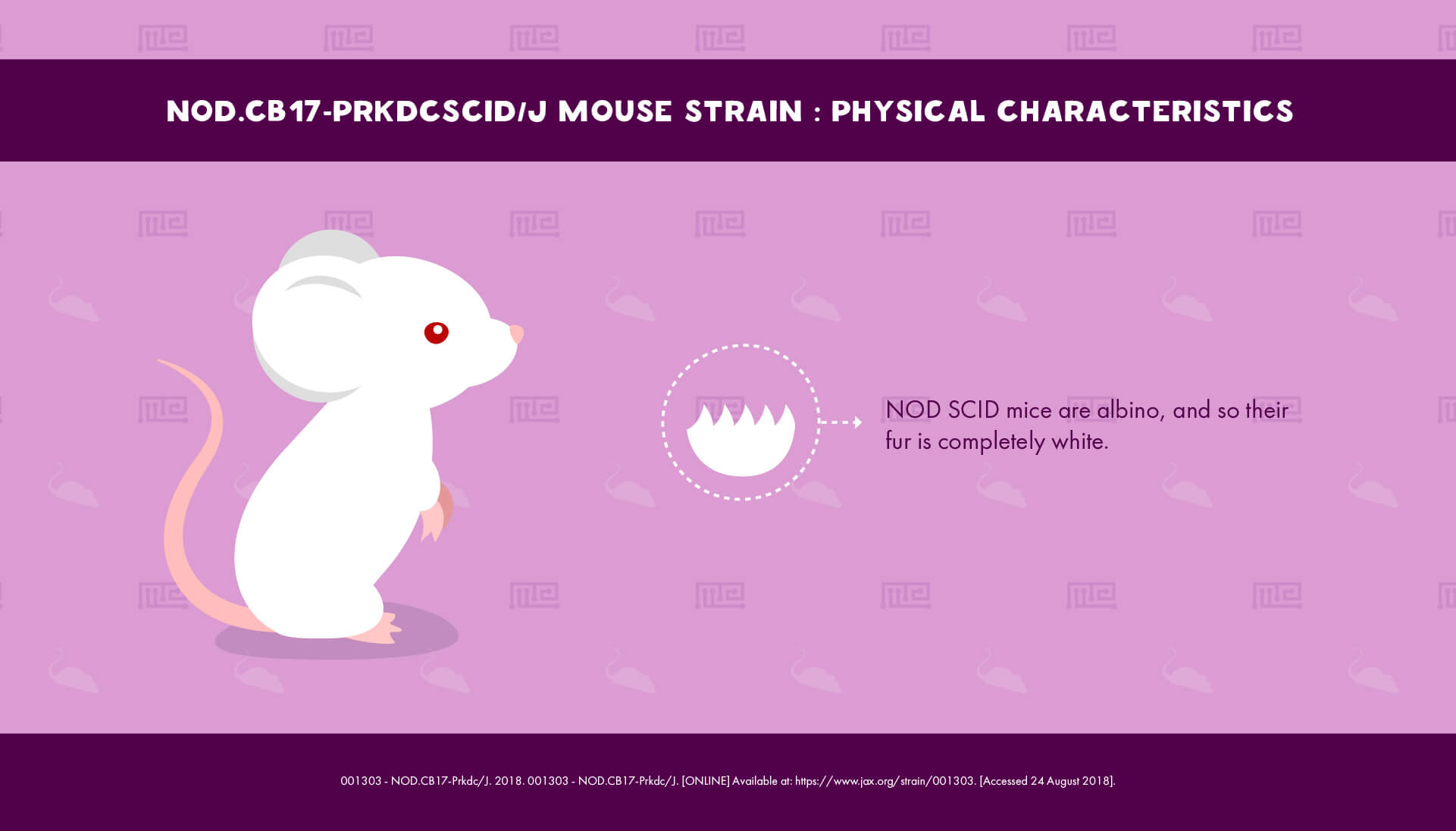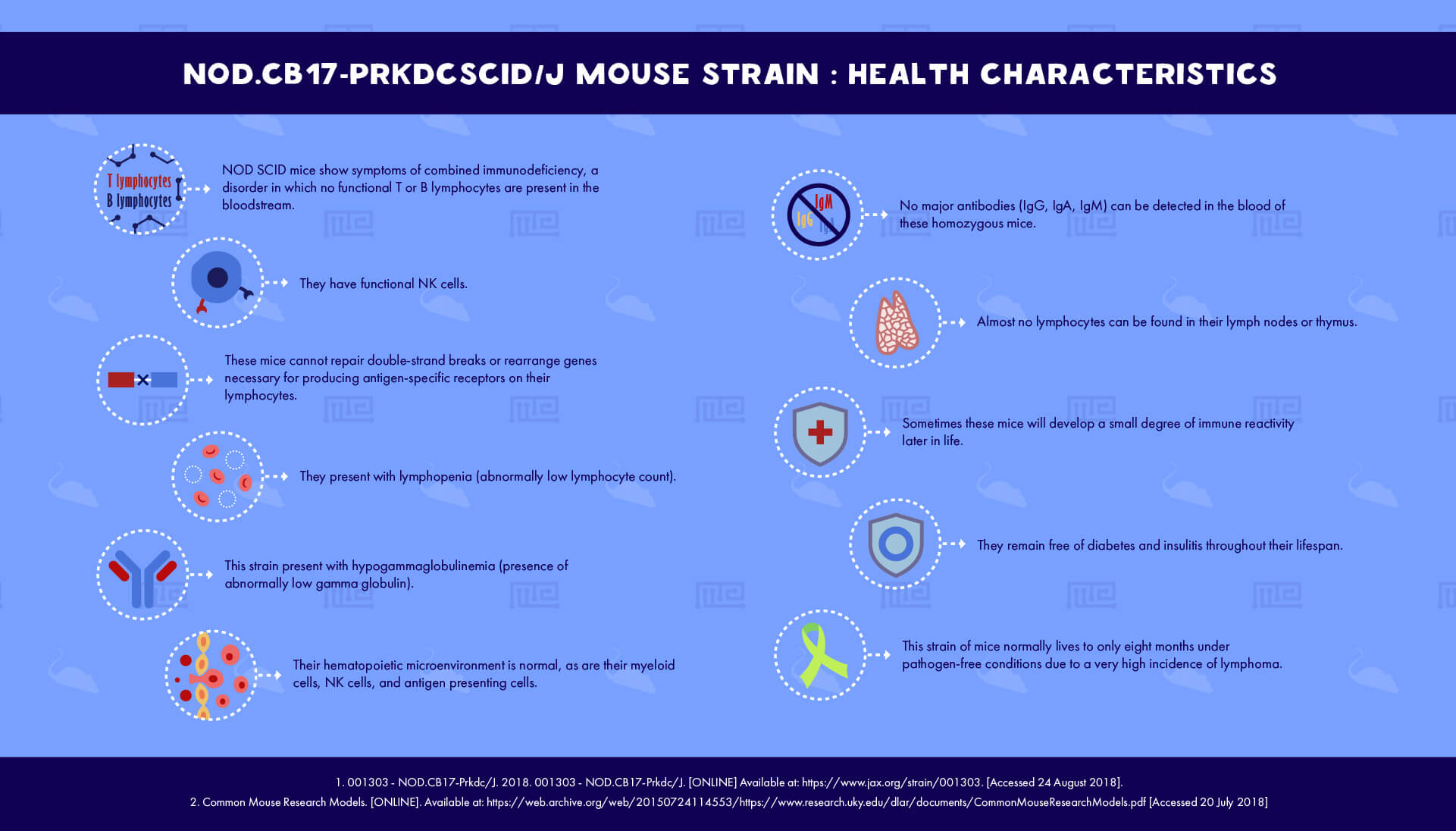Overview
NOD.CB17-Prkdcscid/J, also known as NOD SCID, is a strain of inbred mouse model that is most noted for exhibiting a highly severe immunodeficiency.
History
The NOD SCID strain was originally derived from a stock of BALB/c mice kept at the Institute for Cancer Research in Philadelphia; these mice acquired a spontaneous mutation in the catalytic subunit of the protein kinase PRKDC, conferring severe immunodeficiency.[1]
The immunodeficient mice, known as C.B-17-Prkdcscid, were then crossbred with a NOD/ShiLtSz mouse for ten generations before sibling inbreeding began. The result of this final inbreeding stage was the current NOD (non-obese diabetic) SCID (severe combined immunodeficient) stock.[1]
Physical Characteristics
NOD SCID mice are albino, and so their fur is completely white.[1]
Behavioral Characteristics & Handling
These mice have been described as “very active” and “jumpy”. They reproduce well with large litters.[2]
Detailed information on the aggression and/or ease of handling of this strain could not be found. Researchers should bear in mind however that the presence of SCID in these mice means they must be handled with care and under sterile conditions at all times.
Health Characteristics
NOD SCID mice exhibit severe combined immunodeficiency, a disorder in which no functional T or B lymphocytes are present in the bloodstream. They do have functional NK cells, unlike the related NSG strain.
The SCID results from a mutation in the DNA repair enzyme PRKDC, meaning the mice cannot repair double-strand breaks or rearrange genes necessary for producing antigen-specific receptors on their lymphocytes.[1]
They also present with lymphopenia (abnormally low lymphocyte count) and hypogammaglobulinemia (abnormally low gamma globulin presence). Their hematopoietic microenvironment is normal, as are their myeloid cells, NK cells, and antigen presenting cells. None of the major antibodies (IgG, IgA, IgM) can be detected in the blood of homozygous NOD SCID mice, and almost no lymphocytes can be found in their lymph nodes or thymus.[1]
Sometimes these mice will develop a small degree of immune reactivity later in life. Moreover, some SCID mice are labeled as “leaky”, since they do show some immunoglobulin presence in the blood from the start of life, although leakiness is very low in the NOD SCID strain.[1]
They remain free of diabetes and insulitis throughout their lifespan, which, due to a very high incidence of lymphoma, normally extends to only eight months under pathogen-free conditions.[1][3]
Major Experimental Uses
NOD SCID mice are most useful in the study of immune deficiency disorders and autoimmune disorders, such as the human varieties of SCID and hypogammaglobulinemia.[1][4]
As a consequence of their almost entirely absent immune system, NOD SCID mice are also perfect for cell transfer experiments; they will accept allogeneic and xenogeneic grafts without showing immune rejection. This also means they can accept malignant tissue grafts and be applied in cancer research.[4]
Their refractoriness to diabetes and insulitis makes them a useful control in experiments with NOD/ShiLtJ mice. They can also find application in investigating the role of T cells in autoimmune diabetes, as well as providing a way to obtain pancreatic islets free of insulin.[1][4]
References
- [001303 – NOD.CB17-Prkdc/J. 2018. 001303 – NOD.CB17-Prkdc/J. [ONLINE] Available at: https://www.jax.org/strain/001303. [Accessed 24 August 2018].
- The Jackson Laboratory Handbook on Genetically Standardized Mice. [ONLINE]. Available at: https://www.urmc.rochester.edu/MediaLibraries/URMCMedia/animal-resource/forms/documents/JAX-Handbook-Genetically-Standardized-Mice.pdf. [Accessed 24 August 2018].
- Common Mouse Research Models. [ONLINE]. Available at: https://web.archive.org/web/20150724114553/https://www.research.uky.edu/dlar/documents/CommonMouseResearchModels.pdf [Accessed 20 July 2018]
- The Jackson Laboratory. 2018. NOD.CB17-Prkdcscid/J strain an ideal model for cancer and autoimmune disease. [ONLINE] Available at: https://www.jax.org/news-and-insights/2004/october/nod-cb17-prkdc-scid-j-strain-an-ideal-model-for-cancer-and-autoimmune-disea. [Accessed 24 August 2018].


